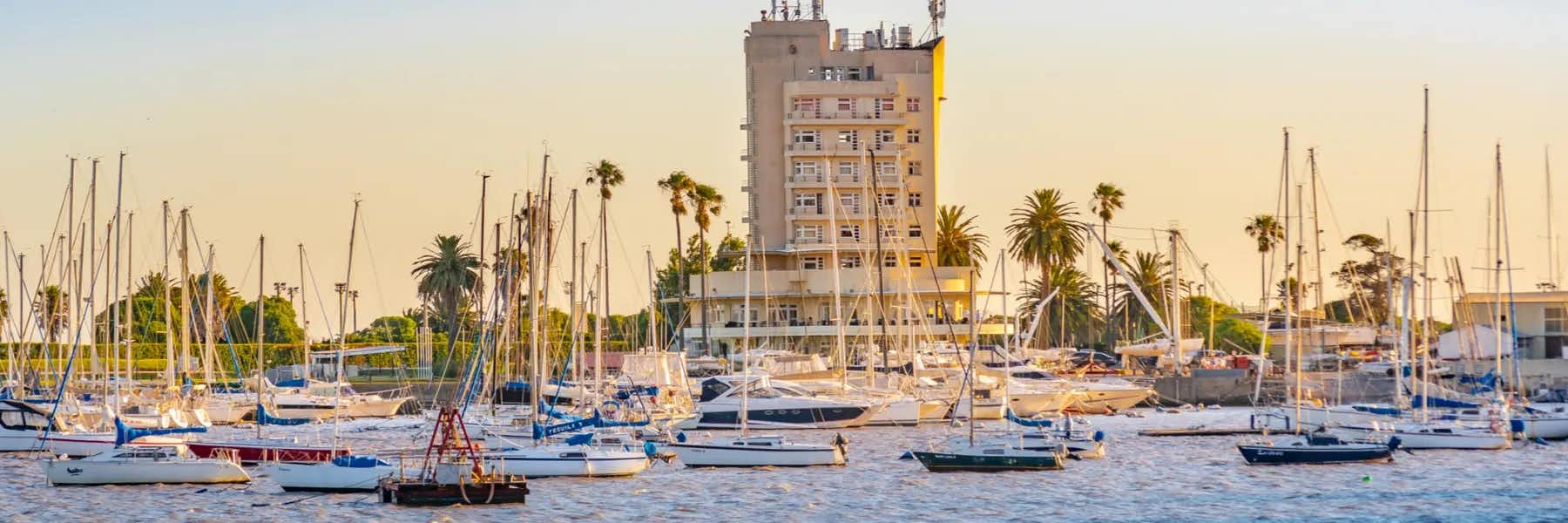Why retire in Uruguay? For starters, Montevideo, Uruguay’s capital, is the city Mercer ranks highest for quality of life in South America.
Then there’s the fact Uruguay is not in a hurricane path and isn't prone to earthquakes.
You can get residency (and in three to five years of citizenship) with no requirement to make an investment or pay a large fee.
And as a retiree living in Uruguay, your social security and/or pension income from abroad is not taxed. This is an important detail. Especially if you’re living on a fixed income.
About Uruguay
Uruguay is a small country with 3.5 million residents. About half the population lives in or near Montevideo.
Located below the tropical zone in the Southern Hemisphere, Uruguay has four seasons. Summers are comfortably warm, with an average high temperature of 82 F. The average winter high is 58 F, cooling down to 43 F at night. Freezing temperatures are rare.
Uruguay’s southern coast—with its long sandy beaches, rocky points, and lighthouses—is popular with summer vacationers. Most of Uruguay’s interior is vast rolling planes lined with scenic rivers used for cattle grazing and farming.
As for infrastructure, Uruguay’s electric grid, telecommunications network, and water treatment systems are among the best in the region. You’ll also find quality health and dental care, with hospitals and clinics throughout the country.
What Does it Cost to Live in Uruguay?
The cost of living in Uruguay depends on your lifestyle.
If you’re a value-conscious retired couple seeking a comfortable life with enough financial cushion to have some fun, you’ll probably want a monthly income of around $3,000.
In regard to cost, there’s not much difference between living in Montevideo and a small town. In Montevideo, rents are higher, but the reliable bus service and taxis make it easy to get by without the cost of owning a car. In small towns along the coast and in the interior, rent is often less, but you may need a car to get around.
Best Places to Retire in Uruguay
Video Transcript
Uruguay is a small country on the east coast of South America between Brazil and Argentina. Uruguay's interior is part of the South American Pampas used for cattle grazing and farming. On Uruguay's coast, you find beautiful sand beaches popular with vacationers. In summer, the average high temperature is around 80 F, cooling down to the mid-60s F at night. In the wintertime, the daytime high is in the high 50s F, cooling down to the mid-40s F at night.
I moved to Uruguay in 2006 and I've lived here ever since. For me, it's been a good fit. I lived in the beach town of Punta del Este for more than seven years, and I've been living here in Montevideo, Uruguay's capital, for more than five years. Okay, let's get started looking at the top five places for expats in Uruguay. Starting here in Montevideo.
1. Montevideo
Montevideo is Uruguay's capital and largest city. It's located on the Rio de la Plata, which translates to River of Silver. But it's actually a large sea like estuary off the Atlantic coast. Montevideo was established in 1730, and grew up around the Bay of Montevideo, which is the best natural harbor in the region. Today Montevideo is a city of 1.4 million people. That's almost half the population of all of Uruguay. It's a city Mercer ranks number one for quality of life in South America. In Montevideo, you find beautiful plazas, large green parks, and tree-lined streets. Like most Latin American cities, you'll notice Spanish influences. But what is a little bit unique about Montevideo is you also notice lots of Italian influences in architecture and the culture. This is because 65% of all the people in Montevideo are of Italian descent. Along the coast in Montevideo, you'll find sandy beaches. You also find the Rambla.
The Rambla is a wide coastal walkway that runs 13 miles along Montevideo's coast and makes an ideal place for walking, running, or riding a bike. For shopping, you'll find a lot of choices in Montevideo. You have shopping malls, you have large grocery markets, but you also have neighborhood stores. You'll have your neighborhood market, a neighborhood baker, your neighborhood butcher, your neighborhood produce stand, neighborhood pharmacy. And in most places in Montevideo, in your own area, you can find just about everything you need within walking distance. The bus service in Montevideo is really good. Buses are well routed and they come by frequently. You also find plenty of taxis which makes it easier to get by without a car.
One of the most popular areas of Montevideo with expats is the Pocitos area. Here you will find two shopping malls, more than 100 restaurants to choose from, large parks, and a long sandy beach. It's an easy place to live without a car.
2. Punta del Este
Punta del Este is the most prestigious beach resort in all of South America. It's often compared to the Hamptons of Long Island, New York, or Saint-Tropez in France. It's located in the department of Maldonado. A department is like a state or a province. Punta del Este's year-round population is about 25,000, but that jumps up to hundreds of thousands during the southern hemisphere's summer months of January and February, when all the vacationers and snowbirds come to town. With that said, it's also a comfortable place for year-round living. And many expats are doing just that.
The city of Punta del Este includes the Punta del Este peninsula and several other neighborhoods on the mainland. After living in Punta del Este for seven years, one of the areas I recommend most is near the base of the peninsula. At the base of the peninsula, you can walk onto the peninsula very easily. You can walk down Gorlero Street, the main street, see the main plaza, go to the top restaurants and clubs, visit the marina, and all the great things on the peninsula. At the base of the peninsula is also where you find the best beaches. You're close to the main bus terminal. And with all the shops and everything around, it's a really easy place to live without a car.
3. Maldonado
Joining Punta del Este is the city of Maldonado. Maldonado is the capital of the department that is also named Maldonado. It's a middle-class city of about 70,000 people. You find shopping stores, services, restaurants, and everything you need in Maldonado. One of the things that's interesting is when Punta del Este gets quiet in the wintertime, when the vacationers leave, Maldonado stays the same. It's a full-time population. The most popular neighborhood in Maldonado for expats is known as Pinares. Pinares is a suburban neighborhood of single-family homes close to the beach. In fact, it's just six-and-a-half miles away from the Punta del Este peninsula. It looks and feels like Punta del Este, but because it's technically Maldonado, it costs less.
4. Rural Maldonado
As mentioned, Maldonado is the name of the city, and it's also the name of the department, which is like a small state or province. Two of the coastal cities in the department of Maldonado, include Punta del Este, which we've already discussed, and another one called Piriápolis. Inland from Piriápolis and Punta del Este, the landscape quickly turns rural. You have lots of small farms and country estates in that area. This provides a desirable lifestyle for many expats. You could live in a country, but be close to places like Punta del Este for shopping, going out to dinner, or for social opportunities. One of the most popular places in rural Maldonado for expats is a town called Pueblo Eden.
Pueblo Eden is just four blocks by four blocks in size. In my opinion, this is one of the most beautiful rural areas in Uruguay. Many expats from both the U.S. and Europe have bought small rural properties and farms in this area.
5. La Paloma
Sixty-two miles east of Punta del Este is the coastal town of La Paloma. La Paloma is in Uruguay's department of Rocha.
Rocha is the least developed department on Uruguay's coastline. The Department of Rocha is where you find country landscape of grazing, pastures dotted with palm trees coming down all the way to the coast where you have gray-sand beaches and blue Atlantic waters. In La Paloma, you find services you don't find in other coastal cities in Rocha, such as a gas station or a bank, because La Paloma is a coastal town. The full-time population of 3,500 grows to more than 30,000 when vacationers and snowbirds come during the Southern Hemisphere summer months of January and February. If you want a low-key beach town that costs less than many other places in Uruguay, La Paloma is a good choice.
Five Reasons to Retire in Uruguay

Choosing a retirement country deserves research and self-reflection. Everyone has their own priorities.
To help your process, I offer, what I consider, five good reasons to retire in Uruguay.
1. A Retirement Haven That’s off the Beaten Path
If you’re the adventurous type, looking for a retirement destination that’s off the beaten path, Uruguay may be just the ticket.
How far off the beaten path? Let me share some perspective. Ninety percent of the world’s population lives in the Northern Hemisphere. So if you retire in Uruguay, you’ll be living in a small agricultural country with a small population located on the half of the planet where only 10 percent of the world’s population lives in the first place.
If you’re from North America or Europe, the seasons will be opposite from what you’re used to. January will come in summer and August in winter. The stars you’ll see at night will be different, too.
Even some of Uruguay’s traditions may be different than what you expect. For example, about a third of Uruguayans are descendants of Italian immigrants. So when it comes to pasta, opera, and winemaking, Uruguayans know what they’re doing.
Then, there's the different wildlife you’ll see in Uruguay. Have you ever seen a ñandú (Rhea americana)? It’s the South American cousin to the emu and ostrich. Or how about a carpincho (capybara)? It looks just like a guinea pig but can grow to more than 100 pounds.
When you’re in Uruguay, you’ll know you’re not in Kansas (or wherever you’re from) anymore.
2. Interesting Lifestyle Options – City, Beach, Country
Whether your dream retirement involves city life, beach life, or country life, you can find it in Uruguay.
City Life
In Montevideo, you find the greatest variety of dining, entertainment, and social opportunities, as well as Uruguay’s largest international community.
In addition to retired expats, you’ll meet English-speakers from all over the world including English-teachers, diplomats, and employees of international companies with a presence in Uruguay.
As an expat in Montevideo, you can choose from a range of interesting places to meet friends for lunch, coffee, or dinner. Entertainment options include seeing a movie (often with showings in English), club music, or attending a performance of the Montevideo Philharmonic Orchestra.
Beach Life – Resort Setting
Eighty-eight miles East of Montevideo, is Punta del Este, the most developed beach resort in Uruguay.
Punta del Este attracts summer beach-goers from many walks of life. During the peak of high season, the local airport fills with private jets and the harbor fills with visiting boats, including large yachts.
As an expat living in Punta del Este, you may enjoy the beach, tennis, or golf. Nightlife ranges from pizza and bowling to fine dining followed by an art event.
When summer passes and the vacationers and snowbirds leave, Punta del Este gets quiet. So quiet they turn off some of the traffic lights. Also, prices for most goods and services are higher in Punta del Este than in Montevideo. While a couple can live in Punta del Este on $3,000 per month (and some do), most expats spend significantly more.
With that said, you’ll find the most retired expats in and near Punta del Este than anyplace outside of Montevideo.
Beach Life – Low-Key Setting
Between Montevideo and Punta del Este, you’ll find two smaller beach towns popular with expats. One is Atlántida, with its many trees and golden-sand beaches. Another is Piriápolis, known for its hills, Mediterranean feel, and boat harbor.
Like Punta del Este, summers are busy with vacationers and part-timers and winters are quiet. Many like the rhythm of the year, with lots of socializing in the summer followed by quieter winter months, perfect for walking the dog on the beach, lunching with close friends, and reading by the fire in the evening.
Country Life
As an expat retiree living in a rural town or on your own gentleman’s farm, you may find yourself buying fresh eggs or homemade cheese from your neighbors; barbecuing with visiting friends; and enjoying the amazing display of stars at night.
3. Culture of Inclusiveness
When I ask expats what they like best about living in Uruguay, the answer usually includes some aspect of the local culture.
One facet of Uruguayan culture I really appreciate is the value placed on inclusiveness.
It seems a real effort is made to give as many people as possible access to the good things in life. It’s reflected in the fact that Uruguay has more of a middle class than anyplace else in Latin America.
You’ll find well-kept public spaces, such as plazas, large parks, and recreational facilities in cities across the country.
All beaches in Uruguay are public and readily accessible. In places like Punta del Este, local services workers enjoy the same beaches and resort atmosphere as energy-industry tycoons and supermodels.
The two top performance theaters in Montevideo, the Solís Theatre and Adela Reta National Auditorium SODRE, schedule occasional free and low-cost events so that everyone who desires can enjoy a night of chamber music or take their kids to see a production like the Nutcracker.
In Uruguay, just about everyone who works can take a vacation. That’s because most workers get 20 consecutive days of vacation time per year with double pay. It enables them to pay their household bills with money left over to really take a vacation.
4. Affordable Healthcare
In Uruguay, quality healthcare at a reasonable cost is a reality, thanks to private hospital plans known as mutualistas.
With a mutualista, you enter into a membership agreement directly with a hospital that provides all your medical services. It’s a straightforward health care solution with no tricky terms.
Hospitals that offer mutualistas provide responsible care to members for less than $60 per month plus a small copayment when you visit a doctor or get a test. As private businesses, each hospital sets its own acceptance standards for age and preexisting conditions. Some are stricter than others.
The health care option with no restrictions for age or preexisting conditions is Uruguay’s public healthcare system ASSE (The Administration of State Health Services). It’s available to any expat retiree who becomes a legal resident of Uruguay. The monthly cost is similar to a mutualista.
While a mutualista is usually the preferred option for retired expats, ASSE can make sense for those who need specialized care or drugs only available through the university hospital (part of ASSE) or who live in rural areas, where ASSE is often the best option.
5. A Clear Road Map to Residency and Citizenship
As mentioned, Uruguay doesn’t require a large fee or investment to become a resident or citizen. The basic qualifications to become a resident retiree are simple: pass a criminal background check and have enough retirement income to support yourself (often about $1,500 for a single person).
Single people can apply for citizenship five years from the time they apply for residency. Married couples can apply for citizenship three years after they apply for residency.
In Montevideo and Punta del Este, you’ll find experienced English-speaking relocation specialists. They’re set up to guide you through the residency process, help sign you up for a health plan, open a bank account, or provide translation services when you need it.
Featured Image Copyright: ©iStock.com/Rudimencial














